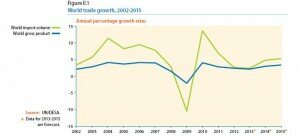Growth of international trade flows weakened even further in 2013
 With demand in many developed countries still low, and growth faltering in developing countries, 2013 has seen a further slowdown in trade. There is some improvement expected in the forecast period, with demand rising in developed economies and activity recovering in developing countries. Trade balances are expected to remain virtually the same between now and then. Trade in services has fared somewhat better than goods, particularly exports from developing countries. There has been some progress on multilateral trade, with a limited agreement reached on 7 December 2013 at the World Trade Organization (WTO) Ninth Ministerial Conference, held in Bali. Significant developments are also possible in the area of large regional trade agreements (RTAs), which have the potential to cover a majority of world trade if they are approved. For the moment trade is being driven by larger
With demand in many developed countries still low, and growth faltering in developing countries, 2013 has seen a further slowdown in trade. There is some improvement expected in the forecast period, with demand rising in developed economies and activity recovering in developing countries. Trade balances are expected to remain virtually the same between now and then. Trade in services has fared somewhat better than goods, particularly exports from developing countries. There has been some progress on multilateral trade, with a limited agreement reached on 7 December 2013 at the World Trade Organization (WTO) Ninth Ministerial Conference, held in Bali. Significant developments are also possible in the area of large regional trade agreements (RTAs), which have the potential to cover a majority of world trade if they are approved. For the moment trade is being driven by larger
macroeconomic trends as opposed to changes in policy; this may shift in the medium term.
Growth of international trade flows weakened even further in 2013, after anaemic growth in 2012. Sluggish global output growth has weighed on international merchandise trade flows, with feeble import demand in major developed economies and moderate demand in a number of large developing countries. World export volumes are set to increase only 2.3 per cent for 2013, lower than the pace of 3.1 per cent in 2012 and well below trend growth prior to the global financial crisis (figure II.1). Some improvement is expected in world trade flows in the outlook for 2014-2015, as global output is projected to strengthen gradually. Slightly improved demand in Europe (from a recession, admittedly), a continuation of the recovery in the United States of America, and an expected rebound in the trade dynamism of Asia are anticipated to drive growth of world exports to 4.6 per cent in 2014 and 5.1 per cent in 2015—more in line with the historical pattern of the ratio of trade growth to global output growth.
The geographic pattern of world trade flows continues to shift. The share of exports is almost equal for developed and developing countries, although imports of developed countries are still leading developing countries.
Source* World Economic Situation and Prospects 2014, UN





There are no comments at the moment, do you want to add one?
Write a comment